At the end of World War II, the French Army was equipped with various weapons made by the National arms factories, but were in small quantities or out-of-date. There were also a variety of American, English or German material in inventory.
Handguns were primarily represented by the Models 1935 S and 1935 A, whose production could be restarted and the Colt M1911A1 provided by our Allies, a few P 08 and P 38s manufactured in 1945 and 1946 by the Mauser factory in Oberndorf. Assitionally, several commercial models, such as the MAB D, Browning M1910/22, Mauser Hsc or Mauser 1914 and the inevitable Ruby, which encumbered regimental arms stores until the 1960s.
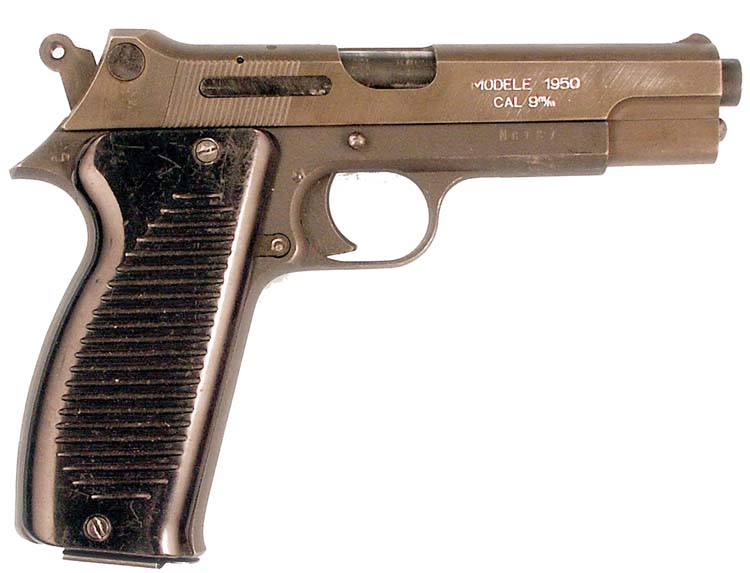
For the purposes of modernization and standardization, the French general staff published on October 30, 1946, the specifications for a new automatic pistol.
- Maximum weight 650 grams (1.43 lbs) without magazine.
- Barrel length between 10 and 12 cm (3.93 and 4.72 inches).
- Cartridge muzzle energy higher than 40 kgm (289 ft/lbs).
- Blow back or locked breech operation.
- Magazine capacity nine shots or more.
- The slide must remain open after the last shot.
- The empty magazine must fall freely from the pistol when the magazine catch is depressed.
- Trigger movement around 3 mm (0.11 inch).
- The trigger pull between 2 and 4 kgf (4.4 to 8.8. lbs).
- The pistol must have an external hammer and a firing pin.
- A loading indicator must be present.
- There must be a manual safety.
- Magazine safety.
- Sights will comprise an open U notch and a front sight.
- The angle of the grip will facilitate the natural movement of the pointing.
- Field disassembly must be easy and complete disassembly can be made by a private. (Heretofore, privates were considered cretins, and were not permitted to complete disassembly a weapon.)
Except the weight, which was underestimated, the characteristics of the future weapon were clearly defined. Its developers were directed towards the system Colt-Browning and the 9mm Luger cartridge.
Four experimental weapons were delivered to the Section Technique de l’Armée, which now replaced the old Versailles Proving Ground in 1950:
- two pistols made by MAS, developed from the Model 35 S M1,
- one model made by the S.A.C.M., developped from the pistol M 1935 A,
- a Swiss SIG SP 47/8, serial number 6557, bought in the trade in Switzerland.
Some others made by MAT and MGD (Merlin-Gérin) were tested before but not retained.
The best results were obtained with the SIG pistol where only 0.48% of malfunctions occurred. But the Swiss gun was eliminated because it did not correspond exactly with the program of 1946, which is not a surprise because the tests proceeded without the knowledge of the manufacturer.
The pistols developed by MAS were not the best where 6.52% of malfunctions were observed. They disappeared after the replacement of some parts, but after 2,500 rounds, cracks appeared on the slide. Another prototype with horizontal serrations for finger grips was also tested: it had 2% of malfuncctions, but cracks appeared after 1,800 rounds and the gun was destroyed after 2,232 rounds. Despite these failures, the pistol developed by MAS was retained and adopted on August 16, 1950.
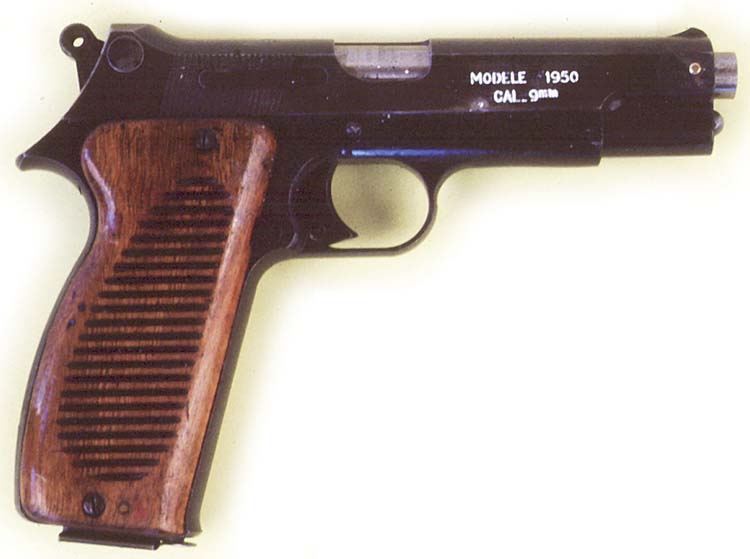
Development continued during the years that followed and three other guns were tested in March 1951 under strenuous conditions. Only a few malfunctions appeared and after 8,500 rounds only two firing pins had to be replaced.
Production
The pistol was first made by the Châtellerault National Small Arms Factory, which produced 221,900 guns from March 1953 to June 1963.
From 1961, the Saint-Etienne National Small Arms Factory gradually took over production of the pistol. The first frames were delivered in October and the final transfer of manufacture took place between 1962 and 1964. This production ceased in 1978, after 120,000 guns were provided. Total production of the M 1950 pistol was 341,900 pistols.
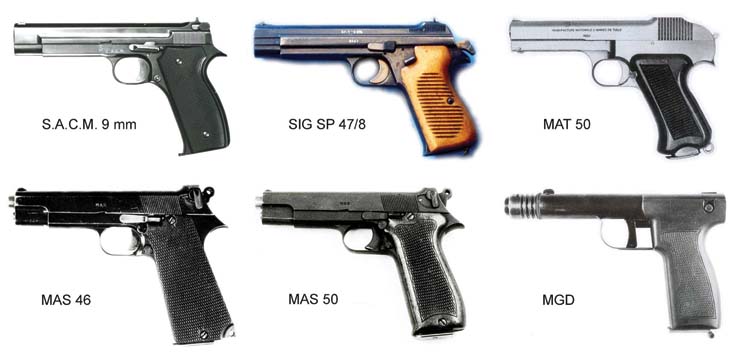
Serial numbers
Pistols made by MAC are numbered in series of 10,000. The first pistol manufactured was numbered A 0001 and the last W 1900. MAS used series of 100,000 for their pistols. The first of them received FG prefix letters and was built between November 1963 and August 1976. Another series of 20,000 pistols with FH prefix letters was made between August 1976 and April 1978. The serial number is on the right side of the frame.
Marks
The left side of the slide and the left side of the lock work receives a MAC or MAS mark. Also, on the right side of the slide can be read the model designation and caliber: MODELE 1950 Cal. 9 m/m
Service
The pistol Modèle 1950 entirely equipped the French armed services (Army, Air Force, Navy, gendarmerie) as well as the C.R.S. (police reserve). It is still used by the Army, except those engaged in Afghanistan. After 1990 it was replaced by:
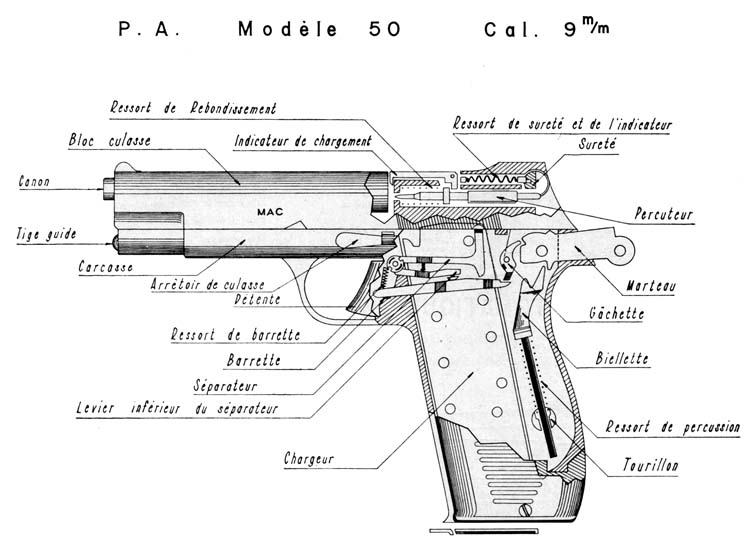
- MAS G 1 (Beretta 92) built under license from Beretta, for the gendarmerie and the Air Force,
- SIG-Sauer SP 2022, for the C.R.S. from 2002. This new pistol is also now used by the gendarmerie, custom office and prison guards.
- HK USP Compact by the Navy.
The pistol Model 1950 is still used by the Army except for troops in Afghanistan or Africa who receives more modern guns (Glock 17 or Glock 19, MAS G 1 or HK USP).
This pistol is also used by former French colonies, such as : Algeria, Burkina Faso, Cambodia, Cameroon, Centrafrican Republic, Comores, Congo, Djibouti, Gabon, Ivory Cost, Laos, Liban, Maroc, Mauritania, Senegal, Togo, Tunisia, Viet-Nam.
Description
The Pistol Model 1950 has a long grip in order to contain the nine-round magazine. It is retained by a catch located at the rear of the trigger guard on the left side. The grip is furnished with black plastic plates striated horizontally and attached by two screws each. The trigger and the tigger guard remain on the frame and the lock work is a removable unit. The base of the grip has a slot and a pin for attaching a lanyard.
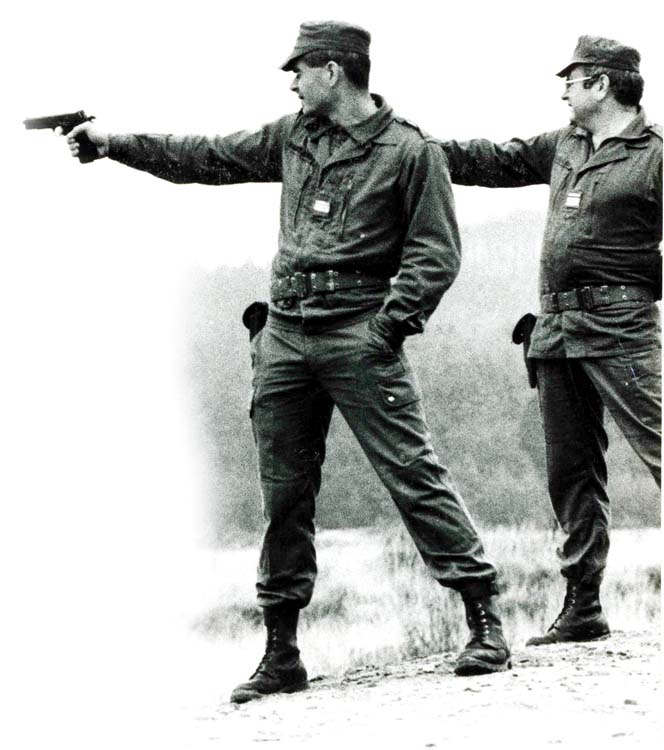
The slide is provided with an ejection port on the right side and a loading indicator on the top. Its side faces comprise oblique grasping grooves. The rear part of the slide receives the rear sight and the safety, as on the pistol Model. 35 S M 1. The sights are an open U notch milled in the safety housing and a fixed front sight with an anti-reflecting rear suface. The slide is locked to the barrel by two tenons. This barrel has a link which swings on the slide stop. Its calibre is 9mm and it has four left grooves instead of six on the prototypes. The Model 1950 pistol has an automatic slide lock which latches the slide open after shooting the last cartridge. It is combined with the disasembly axis. The weapon also has a magazine safety. All the metallic parts are parkerized except the barrel, which is blued.
Disassembly/Reassembly
The disassembly of the Model 1950 pistol is carried out in the following way:
- Put the weapon on safe.
- Remove the magazine.
- Open the slide to check for a cartridge in the barrel.
- Bring the slide back until its notch is opposite the slide stop.
- The slide stop is driven out from right to left, which makes it possible to separate the slide from the frame.
- The barrel and the spring can then be separated while the lock work is extracted from the frame.
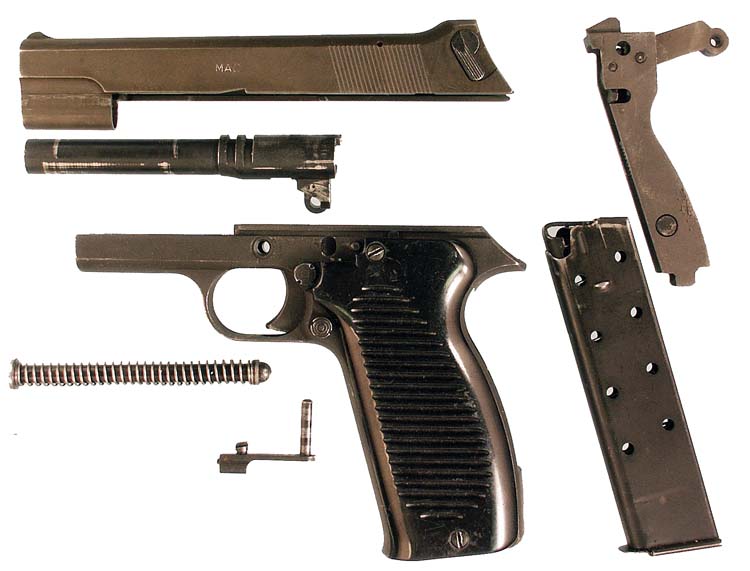
Reassembly is carried out in the inverse order.
Characteristics Model 1950
Caliber: 9mm
Ammunition: 9mm Luger
Overall length: 195 mm (7.67 inches)
Barrel length: 112 mm (4.40 inches)
Height: 142 mm (5.59 inches)
Weight: 950 g (2.09 lbs)
Magazine capacity: 9 rounds
Variations
Some Model 1950 pistols were chrome plated or engraved.
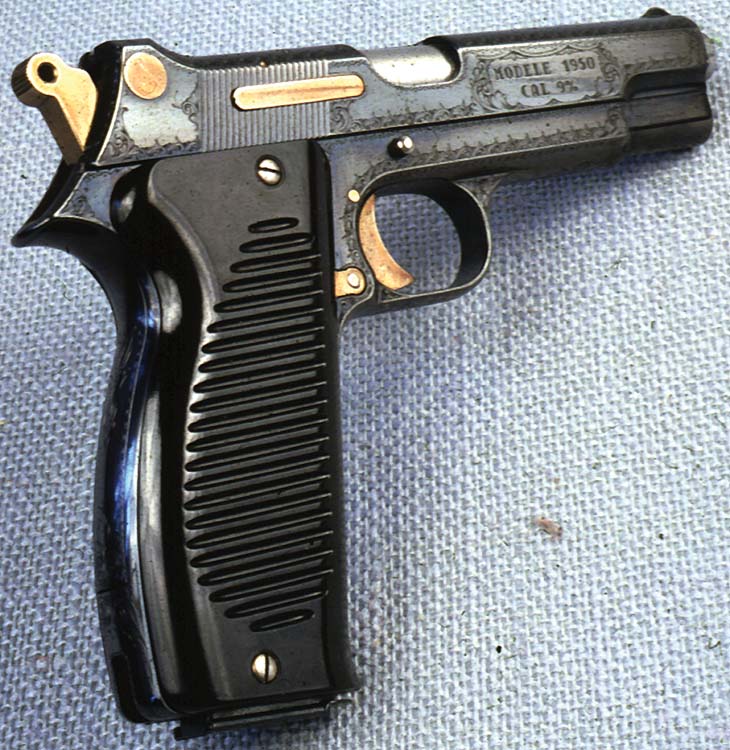
| This article first appeared in Small Arms Review V14N11 (August 2011) |











